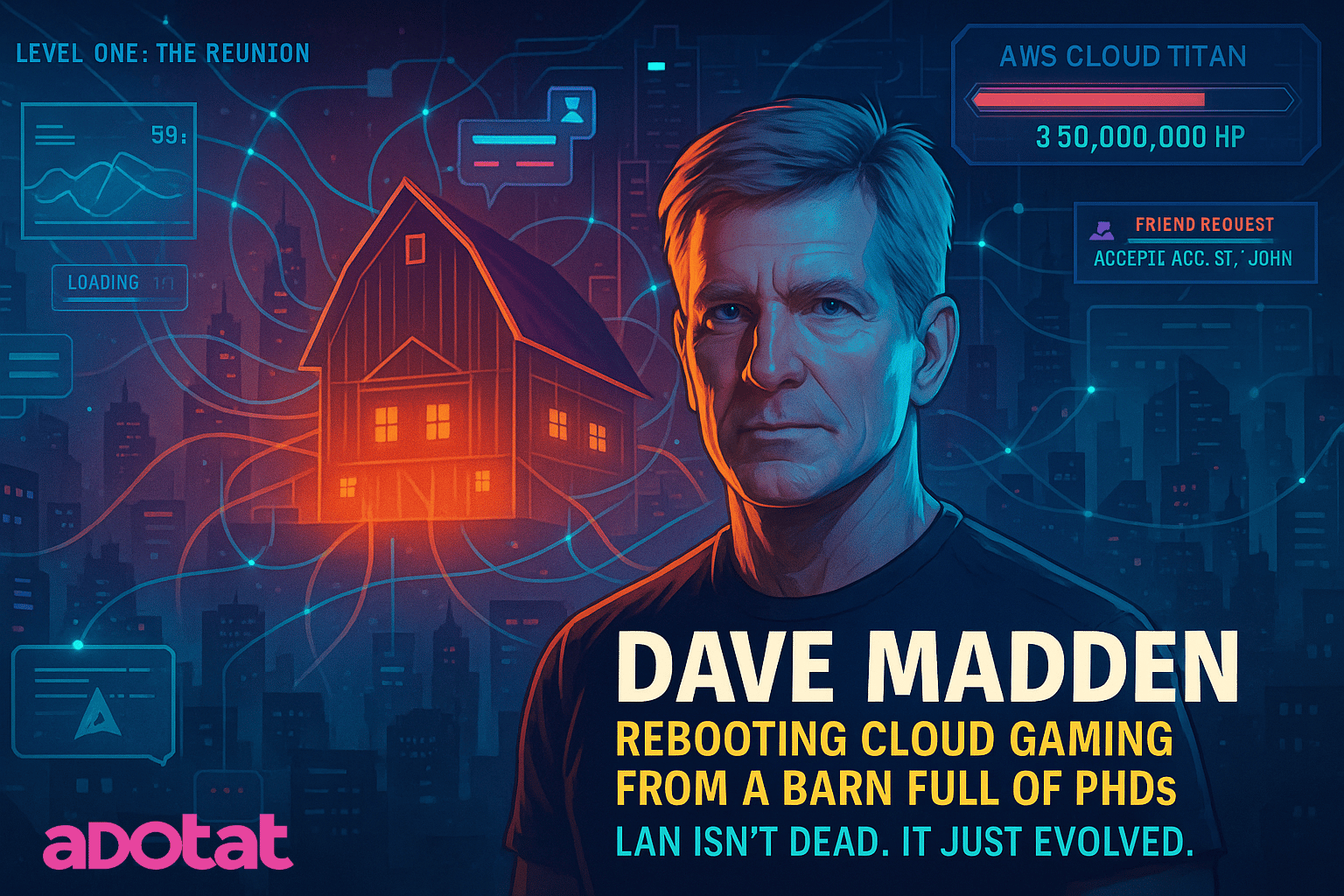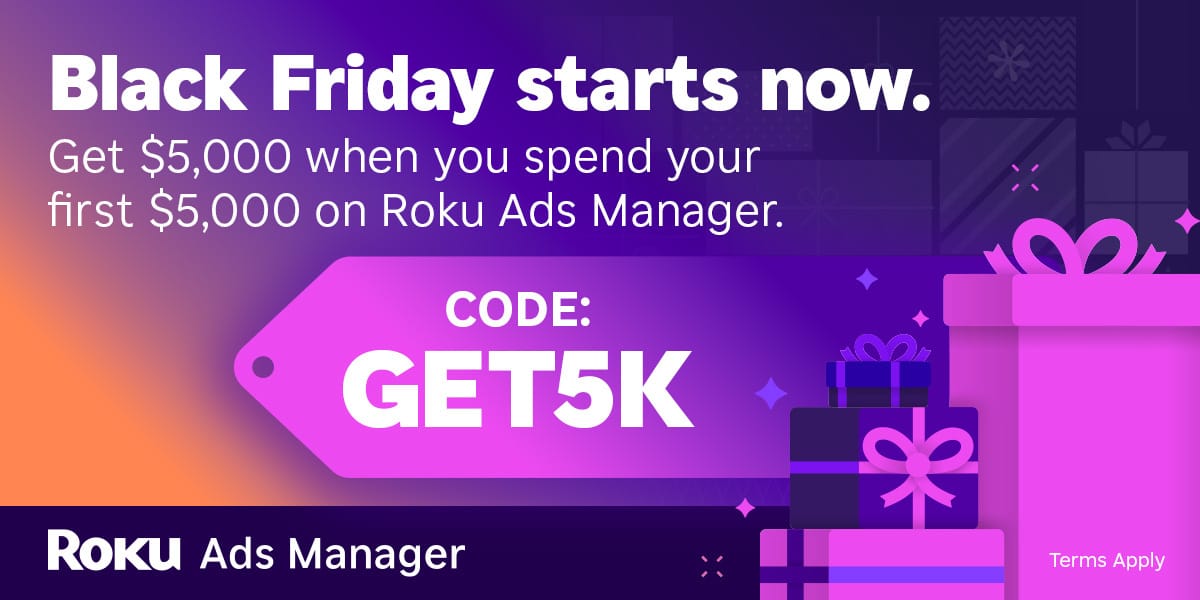Find your customers on Roku this Black Friday
As with any digital ad campaign, the important thing is to reach streaming audiences who will convert. To that end, Roku’s self-service Ads Manager stands ready with powerful segmentation and targeting options. After all, you know your customers, and we know our streaming audience.
Worried it’s too late to spin up new Black Friday creative? With Roku Ads Manager, you can easily import and augment existing creative assets from your social channels. We also have AI-assisted upscaling, so every ad is primed for CTV.
Once you’ve done this, then you can easily set up A/B tests to flight different creative variants and Black Friday offers. If you’re a Shopify brand, you can even run shoppable ads directly on-screen so viewers can purchase with just a click of their Roku remote.
Bonus: we’re gifting you $5K in ad credits when you spend your first $5K on Roku Ads Manager. Just sign up and use code GET5K. Terms apply.
Sign up here |
|
|---|

Why Two Industry Arsonists Decided to Torch the Status Quo Again
The Reunion: Dave Madden, Alex St. John, and the Return of the Chaos Engine
Some reunions are sentimental fluff. This one feels more like two demolition experts realizing the building hasn’t collapsed yet, shrugging, and lighting another fuse. Dave Madden and Alex St. John are not strolling down memory lane.
They’re sprinting back into the arena with sharpened tools and a plan to embarrass the entire cloud-gaming establishment.
And the origin story doesn’t begin in a polished San Francisco incubator or a sterile enterprise lab. No. According to Dave, it started in “a barn with a bunch of PhDs.” He didn’t blink when he said it. That’s how you know it actually happened.
The Barn, the Brain Trust, and the Moment Everything Snapped into Focus
When Dave talked about Alex resurfacing with a prototype, he described it like someone had cracked open a time capsule full of forbidden tech. Alex had spent years “basically in a barn with a bunch of PhDs building a new technology platform for the next generation of gaming,” and the way Dave tells it, this wasn’t eccentric tinkering. This was a controlled lab experiment in how far you can push compute without lighting your wallet on fire.
Dave had been advising here and there, even throwing in some early capital, but the turning point came at Unreal Fest in Orlando. He walked into the demo expecting the usual magic tricks. What he got was something more akin to a paradigm shift. He told me that when he saw it, his immediate thought was, “Wow, this can really change a lot of things about game discovery.”
Dave does not use the word wow lightly. It’s practically profanity coming from him.
That was the moment he went all-in.
Why Cloud Gaming Has Been a Money-Bonfire for a Decade
Dave has been around long enough to know nonsense when he sees it, and he has no interest in dressing it up. He explained that delivering games through traditional cloud infrastructure is “not trivial” and by that he means “astronomically stupidly expensive.”
He spelled it out: if you want to run a cloud-hosted gaming rig through AWS or anyone else, the monthly cost per machine is brutal. Even Google, a company willing to burn billions if it finds the right mood, looked at Stadia and realized the real money was in renting GPU time to AI, not streaming games to consumers.
Dave’s diagnosis of the whole cloud-gaming fiasco was cutting:
“The economics are pretty difficult to imagine scaling anytime soon.”
Translation: no one can afford this except the companies pretending to afford it.
So what do Dave and Alex do? They take the most expensive part of the model and throw it into the trash.
Their answer is a peer-to-peer network, built so games can be streamed like a local area network, not a hyperscaler stress test. Dave described it simply but powerfully: “We really build out a peer-to-peer network of PC devices hosting games.”
It’s LAN energy without the basement.
The Real Prize Isn’t Streaming. It’s Discovery.
Ask Dave where the magic is and he doesn’t talk about latency, codecs, or streaming protocols. He talks about the chokepoint that kills more games than bugs ever will: discovery.
He said it outright: “Video games today are still largely a download business.”
And because everything needs to be downloaded, everything needs to be found.
And because everything needs to be found, everything needs a gatekeeper.
That’s the heart of the problem.
When Playcast makes games streamable instantly, discovery becomes frictionless. You don’t beg app stores for mercy. You don’t fight for ranking. You don’t pray an algorithm takes pity on you. You send a link. Someone clicks. The game loads.
That’s not infrastructure. That’s liberation.
Dave summed it up with quiet clarity: “Games are going to be instantly discoverable on any device.”
That’s the part the industry should be panicking about.
LAN Nostalgia Meets 2035
Dave lights up when he talks about couch co-op. He remembers his kids and their friends passing controllers like it was a sacred rite. And he sees that energy returning in a new form. Netflix is launching co-op titles. Fortnite rewired the social fabric of gaming. The living room is everywhere now.
He put it in a single line that explains the entire Playcast philosophy:
“The couch could be a thousand miles apart.”
That’s the mission.
That’s the product.
And that’s the future the incumbents never built for.
Dave sees the opportunity clearly: reduce cost, multiply access, explode discovery.
LAN is no longer local. It’s cultural.
This Isn’t Nostalgia. It’s the Sequel They’ve Been Saving for Years.
What makes this reunion dangerous isn’t sentiment. It’s intent. These are two men who already helped write the first chapters of modern gaming, now returning because they see the next era forming and the incumbents too comfortable to seize it.
Playcast.io isn’t a love letter to WildTangent. It’s a correction to every bad assumption cloud-gaming vendors have been peddling for years.
Dave and Alex didn’t reunite to reminisce.
They reunited because the industry stopped breaking enough things, and someone had to step up and start again.
And yes, this was just the opening chapter. The next parts of the series go deeper into Dave’s takes on adtech’s parasites, brand soul-loss, the Titanfall meltdown that nearly burned the house down, and the philosophies that kept him from quitting the whole mess.
The good parts are coming. The sharp parts. The uncomfortable parts. The parts people will pretend they didn’t read but quote anyway.
Stay bold. Stay curious. And know more than you did yesterday.

The Rabbi of ROAS
Broken Consoles, Broken Stores, Broken Economics
The industry loves to pretend its foundations are stable. Consoles are “healthy.” App stores are “essential.” Hardware cycles are “predictable.” Sure. And I’m a neutral observer with no opinions. Under the surface, everything is buckling, and cloud gaming isn’t the wrecking ball. It’s just revealing the cracks that were already there.
Let’s start with the app stores, the temples of digital taxation that turned every publisher into a supplicant. For a decade, the narrative was airtight: Apple and Google hold all the doors, and if you don’t like it, you can cry into your 30 percent revenue haircut. Then Tim Sweeney went full crusader and dragged the whole ecosystem into court. Whatever you think of him, he punctured the myth. After years of “this is the only way,” regulators and developers started asking why they’d been paying tolls on roads they already owned.
Now app stores look less like infrastructure and more like extraction schemes exposed in broad daylight. Cloud-streamed games slipping through browser layers terrify them for a reason: the gate is cracking, and the gatekeepers know it.
Then there’s the console lifecycle, which has started to resemble an expensive midlife crisis. The hardware giants wheel out the same choreography every seven years: announce, pre-sell, ship, sell out, repeat. Only now the hits don’t land like they used to. Consumers aren’t rewarding incremental power bumps when their smart TVs can run more computational magic than a PS3 could dream of. The console is no longer the center of gravity. It’s a souvenir.
Microsoft tries to solve this with an identity crisis masquerading as a strategy. They’re leaning hard into cloud dependence, chasing a world where the device doesn’t matter because everything is streamed. It’s elegant on paper and a potential financial aneurysm in reality. Hyper-scale dreams look noble until you see the invoice.
Sony? The opposite problem. Hardware absolutism. Their religion is plastic, silicon, and proprietary everything. They’ll drag the console era into the future even if the future is quietly moving on.
The real threat is sitting in the living room pretending to be harmless: the TV.
Every smart television is now a Trojan Horse with a game engine tucked inside. What used to require a console now requires nothing but a controller and a half-decent internet connection. If you think that doesn’t destabilize the entire ecosystem, ask yourself why every platform-maker is racing to lock down TV integrations before their competitors do.
Cloud gaming didn’t break the console era.
It simply revealed that the whole thing was already cracking at the edges. The stores lost their chokehold. The hardware lost its glamour. The economics lost their excuses.
The tree shook. And the apples?
Some stayed on the branches.
Some hit the ground.
And a few rolled so far under the couch that nobody will bother fishing them out.
Sidebar: Who Is Alex St. John? Alex St. John helped build the original Microsoft DirectX platform alongside Craig Eisler and Eric Engstrom, laying the groundwork for modern PC gaming. He later became Microsoft’s Windows Game Technology evangelist, pushing DirectX into the center of the graphics world and helping turn Windows into a serious media powerhouse.
Why You Need ADOTAT+ (Before the Rest of the Industry Figures This Out)
If you think you “get” why gaming hates adtech, you don’t. Not until you hear Dave Madden torch half the industry with lines you’re definitely not seeing on LinkedIn.
Inside the ADOTAT+ version of this episode, you get the stuff the conference circuit will never admit:
How adtech became “an industry of lampreys sitting on the back of a whale.”
Why Cannes is really just cosplay with rosé.
Why gamers don’t hate ads — they hate being treated like idiots.
Why half the industry sells frosting when the cake was baked two fiscal years ago.
And which brands should be excommunicated from the Church of Soul.
This isn’t fan service. It’s field notes from someone who actually built the gaming economy while adtech was still arguing about “signals.”
If you want the sanitized version, stay free.
If you want the true mechanics of the market, straight from one of the few people who’s actually done the work — that’s ADOTAT+.
Stay Bold, Stay Curious, and Know More than You Did Yesterday.
Subscribe to our premium content at ADOTAT+ to read the rest.
Become a paying subscriber to get access to this post and other subscriber-only content.
Upgrade





